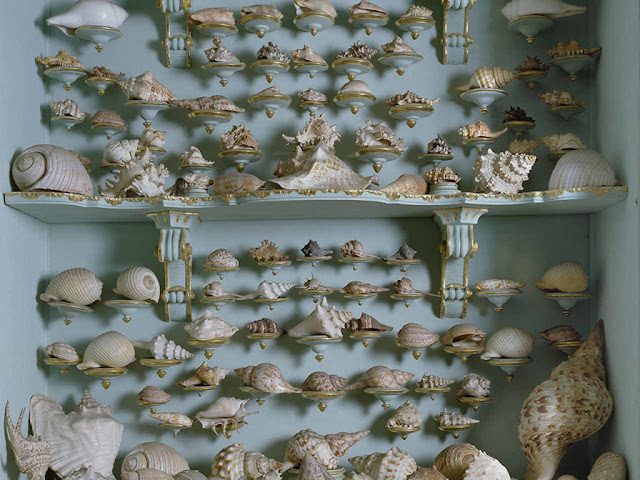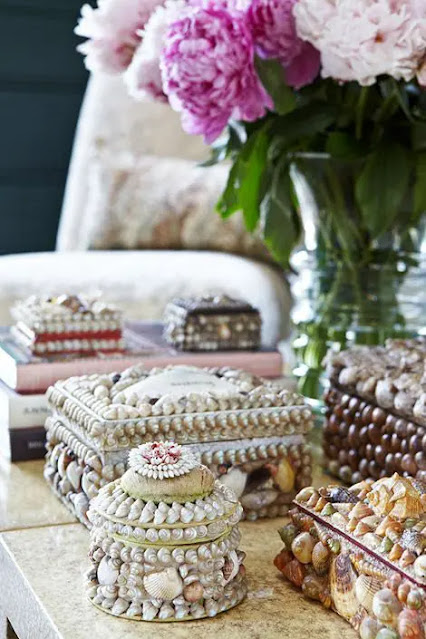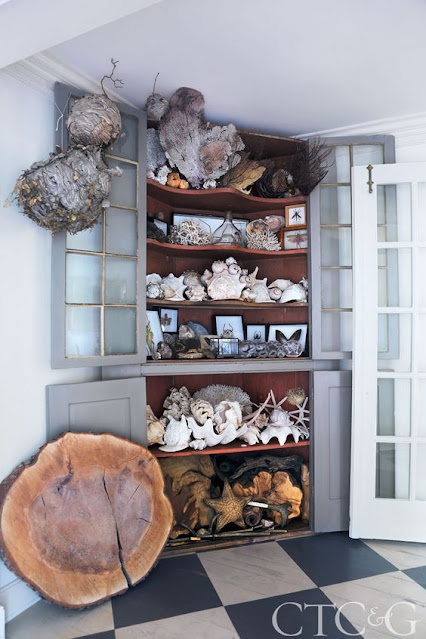Thanks to the revival of the old world maximalism style of decorating, beauty, craftmanship, and history can be collected and appreciated in your homes and you can enjoy beautiful treasures once again. Maximalism is by no means a modern trend but one that veers towards a reinvention of European traditional décor.
This blog post features one area of 17th century maximalistic collecting and display called conchylomania (the collection of seashell art and specimens). Curiosity cabinets would be populated by all sorts of objects of amazement and thanks to the influx of exotic shells and coral to Europe, via The Dutch East India Company, a seashell display cabinet would also have been part of the 17th century home's "wunderkammer" translated from German as a "wonder room". Shells and corals were so popular that the mid-eighteenth century Rococo style derives its name from the French for shell.
Seashell art and display has become popular as today's residents are enjoying the old world obsession with cabinets of curiosities. There is an art to creating beautiful and authentic old world style shell décor. It is not about gathering shells at the ocean and displaying them in jars, baskets etc. It is about marrying these beautiful fossils of the sea to old world display stands, plinths, and other lovely antiques objects, making sure your set the stage with other works of art and beautiful collectibles and treasures from another time in history. And thanks to maximalism you can let your appetite for collecting run free!
Many of us NEVER opted for a minimal interior but maybe this is your first time to collect and curate a beautiful living environment. Notice I said curate! Maximalism has never been about about hoarding unattractive junk. It’s about embracing color and pattern and beauty from across many eras and styles.
Do your homework and learn how to make your seashell collections and décor old world spectacular and awe inspiring! I hope these images will help some of you modern day conchylomaniacs out!
The Renaissance ushered in an interest in natural objects of beauty to put in cabinets of curiosities. Because of their attractiveness, uniqueness, and rarity, shells and corals became a large part of these collections.
Courtesy Bibliotèque centrale du Muséum national d’Histoire naturelle, Paris.
Towards the end of the 17th century, people began looking at shells with scientific interest as well.
Still-Life with Tuft of Marine Plants, Shells and Corals by Anne Vallayer-Coster, 1769.
Seashells were everywhere and were often featured in Dutch still-life paintings ( pronkstilleven ) popular in seventeenth-century Holland.
Beautiful trompe l'oeil cabinet of curiosities with the beginnings of a seashell display.
Conchylomania filled curiosity cabinets across France, England, the Netherlands, and eventually the United States with as many unusual specimens of seashell, coral, and seashell art as one could acquire or create by hobby.
The Dutch East India Company already held a monopoly on the spice trade but also imported porcelain and shells from beaches along the Indian and Pacific Oceans, a sight never before seen by most Europeans. Exotic and newly discovered specimens were especially prized.
It was a time of obsession with all things shell and many wealthy people of the time had a cabinet of curiosities where they kept seashells, corals, and semi-precious stones.
Even the common folk collected and displayed their seashell treasures.
theappendix.net Image courtesy of Wikimedia Commons
Frans Francken’s Kunstkammer, 1636, detail.
By the Victorian era the introduction of the modern public museum caused the wonder room interest to wane. Families might have seashell collections but cabinets were of less interest.
Shells were born of the sea just as, according to Greek and Roman myth, Aphrodite/Venus was. Therefore, shell collecting was deemed highly suitable for ladies as a symbol of love and femininity. Decorating rooms with shells was a popular pastime for ladies of leisure. Centuries ago ladies worked on seashell art much like they did their needlework.
Parlor Domes art form started in France and England and became very popular in America during the Victorian era. One in your parlor was a decorating must! The domes made for the formal parlors were full of wax flowers however seashell arrangements were also highly desired. You would find them residing on a table in the center of the room.
via Pinterest
Ladies took classes to learn the art of creating seashell flowers. They bought kits that were ordered by mail. The seashell flower domes could also be purchased at jewelry stores or other gift stores.
Sometimes they were in pairs and would adorn the fireplace mantle. Even Queen Victoria was a huge fan of seashell art and would often commission gifts of shell work for her friends.
A fun collectible made by Victorian ladies at the height of the trendy seashell décor of the day was shell encrusted figurines and even small pieces of furniture.
Another form of Victorian seashell art that was popular with ladies of the day was seashell covered boxes. They have become popular recently and are being crafted again by DYI's. However, if you wish to collect true antiques here is a bit of advice. A good way to detect if you are purchasing a true antique is to look at the shells. They will be worn and will have acquired some patina.
via Pinterest
The box should be covered in shells that are a bit more unique than what is now found in craft stores. A seashell called pelican’s feet were favorites of the day and are extremely hard to find now.
Also look for keyholes, keys, and hinges that are of the era and not modern. Many antique boxes will have had some repairs yet this will not diminish their beauty or worth.
You can see how pretty seashell art boxes are grouped as part of a vignette whether antique or reproductions like these made today.
During seashell mania the nautilus was esteemed and highly favored for use in décor.
via Pinterest
In the late 18th and early 19th centuries “sailors’ valentines” were extremely popular. You would find designs such as hearts, flowers, and nautical symbols made by gluing hundreds of shells (collected by the sailors themselves) onto cotton batting that could be framed with wood and glass. Many times the sailor would spell out “Forget Me Not” with tiny shells. They would be given to wives and loved ones upon the sailor's safe return home.
One of my favorite ways to decorate with seashells and corals, in an old world style, is with beautiful specimens gracefully arranged on antique bases.
via Pinterest
I love the old world refinement these beautiful pieces bring to a space. There are so many interesting pieces to choose for a base. Tip: Make sure your shells are not bright and shiny!!
Remember you want the seashell art pieces to look like old world artifacts.
via Pinterest
An antique base decorated with a sea fan, barnacles, fossil shells, and coordinating fragments. Sea fans bring a fragile texture and pattern to a piece of seashell art that just seems to elevate the piece in such a beautiful way. Remember to show restraint in creating these beautiful pieces of seashell/coral art.
Lisa Farmer, Eye For Design
On my bedroom mantle I have a large piece of coral and a sea fan coral I glued to a small bronze urn on a marble plinth. I then surrounded the base with some small scallop shells and broken bits and pieces of coral (which you can't really see in the image). If you create you own shell art just make sure to present it in an old world way and that will depend on your choice of display stand.
Elegant and aged to perfection, a collection of seashell/coral art pieces like this would make a stunning addition to an interior style reminiscent of the ancient Italian grottoes.
Candle holders make great bases for seashell arrangements. The chunkier types are best. Plus look for wooden ones as they look more old world than shiny brass. If you do choose metal just make sure it has patina.
It is important that you surround your seashell art sculptures with other old world aesthetics to create an authentic atmosphere so they will look like they belong.
Photo courtesy of Féau & Cie Boiserie
The distinguishing characteristic of precious coral, or red coral, is their intensely colored red or pinkish orange skeleton. These corals make stunning seashell/coral art to be displayed elegantly throughout your home or as a collection.
Coral art under glass......perfection!
@vicdeland on Pinterest via ft.com
Corals and seashells display so beautifully together and evoke a bygone time of fascination with the unusual elegance of nature.
If you crave shell art with old world appeal but don't feel comfortable trying to create them yourself, Greyfreth has been a go to source for several years now.
theappendix.net Image courtesy of Wikimedia Commons
Isidore Leroy de Barde, A Selection of Shells Arranged on a Shelf, watercolor and gouache, 1803.
Seashell inspired art was very popular centuries ago.......
and also is trending today. You may not be able to purchase fine oil paintings but there is lovely art to be had today.
Just make sure it has old world charm and isn't "beachy" art.
Urns and seashell/coral fossils are just meant to be together.
Seashell art adds to the antiquity attributed to old world urns and pedestals. You really can't go wrong displaying shells and corals in this manner.
Lisa Farmer, Eye For Design
When I told my husband several years ago that I was bringing in one of the garden urns for a seashell display he thought I had lost my mind. It gets so many compliments he has changed his.
Lisa Farmer, Eye For Design
Don't fill the urn with shiny shells you buy in craft stores as that won't provide the authentic old world appearance. Make sure to add in some large shells as these were the much desired, hard to find specimens used in cabinets of curiosities.
Maximalism seashell collections and décor makes bringing nature into the home enjoyable as you curate your collection.
These seashell cabinets are not only beautiful conversation starters but they also make for charming pieces of furniture for displaying nature's beauty.
Like Victorian collections, your cabinet could also display unique finds from the sea as you continue to add shells and corals to your décor.
Be creative and find unique ways to display seashell art while keeping it old world.
There are many ways to make a seashell feel like a work of art. Display them on shelves, mantles, use them in vignettes on tabletops, make your own cabinets of curiosities.
Click below to see the previous blog post.
This blog post was published by Lisa Farmer
In the event that I have not credited the correct source of an image, please contact me at lisafarmerdesigns46@yahoo.com and I will be glad to correct it.


.jpg)


.JPG)





.jpg)

.jpg)
.jpg)
.jpg)

.jpg)
.jpg)
.jpg)


.jpg)

.jpg)
.jpg)
.jpg)
.jpg)







.jpg)
.jpg)

.jpg)






2.jpg)

brightened.jpg)



.jpg)
%20(1).jpg)




